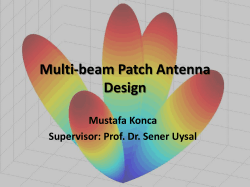
NVIS Presentation
NVIS and the AS-2259/GR PVC Clone Colorado ARES R3D2 Before we get into the ‘how’, let’s start with the ‘why’: Larimer and Weld County comprise 6,656 square miles, with a worst-case distance of approximately 130 miles between any two locations. Half of that is mountainous, sharply limiting line of sight communications. Furthermore, our state Capital can be as far as 300 miles away from another given point in the state. Repeater systems are available for local use, but our larger linked systems are vulnerable to damage, jamming and use by other aid groups. From our ECOM training by Pat Lambert, W0IPL (http://www.w0ipl.net/ECom/NVIS/nvis.htm) as well as previous R3D2 operations, we know that a dipole for 40/80M placed at 10-15’ works best to establish communication in our area. Antenna theory (backed up by experience) shows us that the radiation pattern produced by such a design is mostly straight up – removing mountains from the communications picture. The dual bands available allow for the constantly changing ground and atmospheric conditions, to include the inherent changes that follow the day/night cycle. The issue for us then becomes, how do I construct (or purchase) a suitable antenna? Commercial 40/80M dipoles are available, but can be expensive and frequently come with no support equipment to get the antenna in a suitable position. It’s worth noting that much of our district may not have suitable trees, especially given our histories of flooding and fires. To address issues like ours, a series of plans circulated around the internet regarding a direct clone of the U.S. military AS-2259/GR, a crossed wire diploe that was inexpensive to build with PVC pipe, house wire, #6 brass hardware and an SO-239 bulkhead connector. As I’ve highlighted below, however, these early clones copied the military elements exactly, leaving them nonresonant at our 40/80M frequencies. While a home station with generous amplifier and hearty tuner could make a match and transmit, a field station with limited batteries and challenging conditions would be set up for failure. Thankfully, several ARES groups modeled the antenna and found these issues, and came up with loading coils to artificially lengthen the elements of previously assembled clone antennas. This remains helpful for the 80M legs – we would need over 67 feet per leg otherwise, and although permanent installations are encouraged to do so, the 38’ with coil option is easier and effective for portable use. The 40M legs see no such advantage – one can simply cut those elements to a resonant length, approximately 33’ for our purposes – and dispense with the loading coils without exceeding the original design’s desirable footprint. The installation at the Fort Collins American Red Cross’ chapter house uses these changes in element length, but retain the original clone’s general design and build to realize cost savings: without counting the 75-100’ of RG-8X coax required for a good match on 80M, the complete antenna with its mast, guys and stakes was assembled for under $25, and could have been done for even less had the materials already been on hand. If time and funds are available, additional modifications are recommended in the linked builds below, to include a more rigid enclosure for the SO-239 and hooks on the top mast section to coil the elements. Operators are encouraged to review all of the builds posted and utilize the best characteristics from each. A basic illustration is provided below, with all credit to the various design changes going to their respective original posters. Basic Design: (http://n3oc.dyndns.org/Homebrew%20AS-2259%20GR.pdf) – Note the non-resonant antenna elements. Loading Coil Option: (http://arrl-ohio.org/SEC/nvis/Modified%20AS-2259%20NVIS%20Antenna.pdf) – Note especially the 80M coil construction. Unless you are modifying a previously-built 2259 clone, consider making these coils as an integral part of the element instead of using the wingnuts. Protected SO-239 Option: (http://www.bridgingagap.com/Emergency%20Preparedness/Emergency_Communications/Inf ormation_2_files/NVIS%20AS-2259%20Adaptions.doc.) – Note the top assembly, especially for permanent installations. No-Solder Option: (http://www.gaares.org/documents/w4cng_nvis_support.pdf) – Note his use of resonant elements on both 40 and 80, but also note the length of an 80M leg without loading coils.
© Copyright 2025









